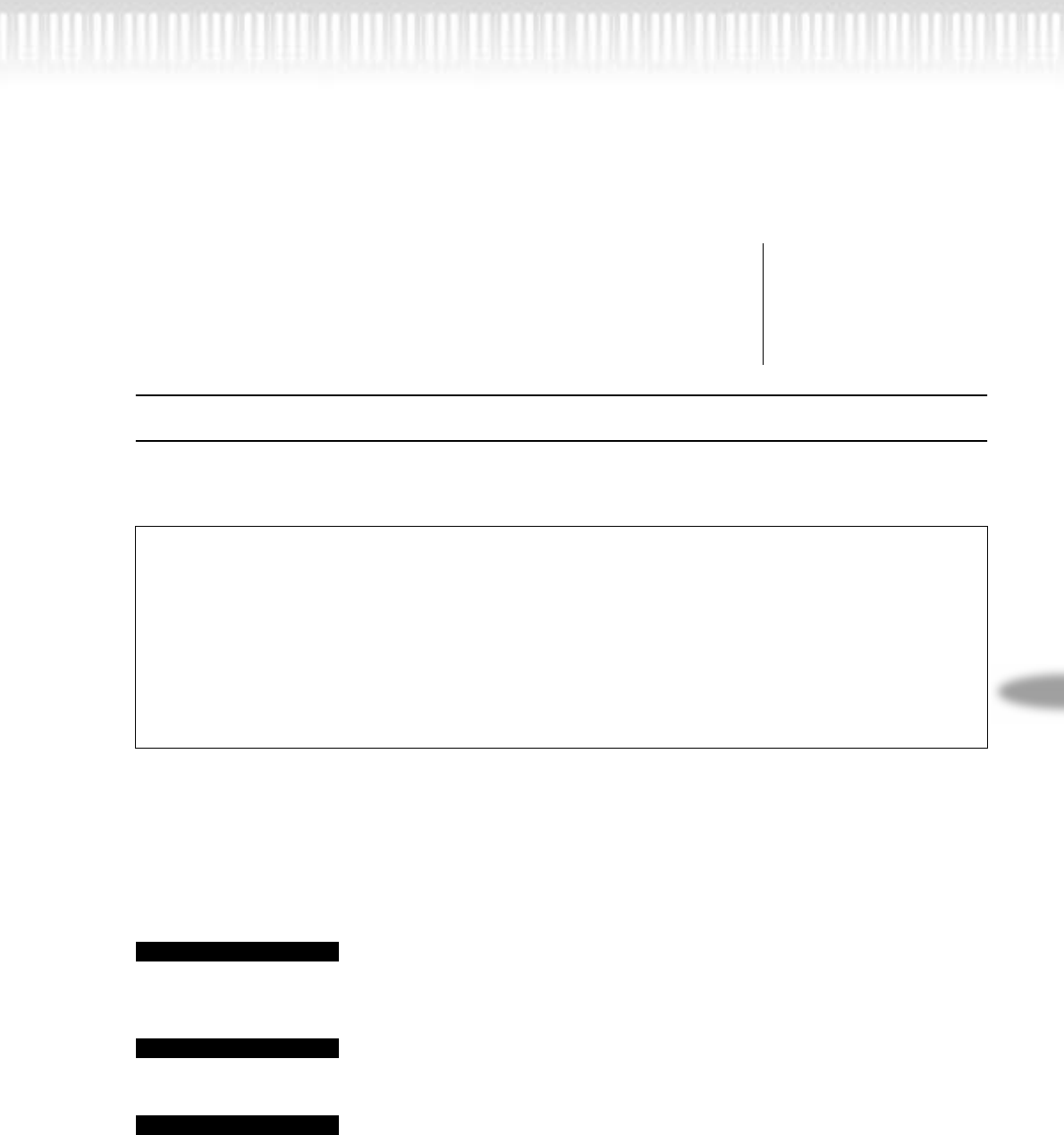Musical Instrument Owner's Manual
Table Of Contents
- PRECAUTIONS
- Table of contents
- Application Index Use this index to find reference pages that may be helpful for your application...
- Handling the Floppy Disk Drive(FDD) and Floppy Disk
- Maintenance
- Included Accessories
- Features
- Before Using the Clavinova
- Part Names
- Listening to the Demonstration Tunes
- Listening to 50 Piano Preset Songs
- Selecting and Playing Voices
- Recording Your Performance
- Saving Recorded Songs and Handling the Files...[FILE]
- Clavinova memory
- Basic file operation
- Saving recorded or other songs to Clavinova Storage memory...[SaveToMemory]
- Saving recorded or other songs to floppy disk...[SaveToDisk]
- Deleting songs in Clavinova Storage memory or a floppy disk...[DeleteSong]
- Renaming a song...[RenameSong]
- Copying data from one floppy disk to another...[CopyDisk]
- Formatting a floppy disk...[FormatDisk]
- Changing the type of characters on screen...[CharacterCode]
- Playing Back Recorded Songs and Commercially-available Music Data
- Connections
- Detailed Settings
- Detailed settings for recording and playback [SONG SETTING]
- Correcting note timing [Quantize]
- Specifying whether playback starts immediately along with the first voicing [QuickPlay]
- Auditioning the channels [ChannelListen]
- Deleting data from each channel [ChannelClear]
- Specifying the range and playing back repeatedly [FromToRepeat]
- Playing back the phrase specified by the phrase number [PhraseMark]
- Playing back a song repeatedly [SongRepeat]
- Detailed settings for the metronome METRONOME [SETTING]
- Detailed settings for the voices [VOICE SETTING]
- Setting the octave [Octave]*
- Setting the volume level [Volume]*
- Setting the position of right and left channels [Pan]*
- Fine tuning the pitch (only in Dual mode) [Detune]
- Selecting the reverb type [ReverbType]
- Setting the reverb depth [ReverbSend]*
- Selecting the chorus type [Chorus Type]
- Setting the chorus depth [ChorusSend]*
- Setting the chorus on/off [ChorusOnOff]
- Selecting the variation effect type [VariationType]
- Setting the variation effect depth [VariationSend]*
- Setting the touch sensitivity [TouchSense]*
- Setting the right pedal function [RPedal]
- Setting the center pedal function [MPedal]
- Setting the left pedal function [LPedal]
- Setting the auxiliary pedal function [AuxPedal]
- MIDI [MIDI SETTING]
- About MIDI
- Setting the MIDI transmit channel [MidiOutChannel]
- Setting the MIDI receive channel (Port A) [MidiInAChannel]
- Setting the MIDI receive channel (Port B) [MidiInAChannel]
- Setting Local control on/off [LocalControl]
- Selecting performance from the keyboard or song data for MIDI transmission [MidiOutSelect]
- Selecting a type of data received via MIDI [ReceiveParameter]
- Selecting a type of data transmitted via MIDI [TransmitParameter]
- Executing song data bulk dump [SongBulkDump]
- Transmitting the initial settings on the panel [InitialSetup]
- Executing voice data bulk dump [VoiceBulkDump]
- About MIDI
- Other settings
- Selecting a touch response [TouchResponse]
- Fine tuning the pitch [Tune]
- Selecting a tuning curve for a piano voice [PianoTuningCurve]
- Selecting a scale [Scale]
- Depth of string resonance [StringResonanceDepth]
- Depth of sustain sampling for the damper pedal [SustainSamplingDepth]
- Setting the speed of vibraphone’s vibrato effect [VibraphoneRotorSpeed]
- Selecting a pedal function for vibraphone [VibraphonePedalMode]
- Assigning the START/PAUSE function to a pedal [PedalStart/ Pause]
- Selecting a type of auxiliary pedal [AuxPedalType]
- Setting the point at which the damper pedal starts to affect the sound [HalfPedalPoint]
- Pitch bend range [PitchBendRange]
- Replacing the XG voices with preset voices [XGAlternative]
- Selecting items saved at shutdown [MemoryBackUp]
- Restoring the normal (default) settings [FactorySet]
- Other method for restoring the normal settings
- Message List
- Questions about Operations and Functions
- Troubleshooting
- Data Compatibility
- Preset Voice List
- Voice Combination Examples (Dual and Split)
- Index

CLP-990 63
Connections
6
MIDI [IN], [OUT], [THRU] connectors
Use MIDI cables to connect external MIDI devices to these connectors.
Make sure you set the HOST SELECT switch (described on the privious page)
to MIDI when you use these connectors.
Connecting a personal computer
You can enjoy computer music data on the Clavinova by connecting a computer to the TO HOST (or MIDI)
jack.
There are the three methods by which to connect the Clavinova to a personal computer:
1. Connecting the serial port on the computer to the Clavinova’s TO HOST jack (page 64)
2. Using a MIDI interface and the Clavinova’s MIDI connectors (page 66)
3. Using the USB port on the computer and the UX256, a USB interface (page 67)
For more information, refer to the following pages.
When connecting the Clavinova to a personal computer, first turn off the power to both the Clavinova and the computer
before connecting any cables and setting the HOST SELECT switch. After making connections and switch settings, turn
on the power to the computer first, then to the Clavinova.
If you do not use the TO HOST jack of the Clavinova, make sure you disconnect the cable from the jack. If the cable is left
connected, the Clavinova may not function properly.
When the HOST SELECT switch is set to “PC-1,” PC-2,” or “Mac,” you can use the TO HOST jack, but the MIDI connec-
tors are disabled since no data transfer occurs via the MIDI connectors. On the other hand, when the HOST SELECT
switch is set to “MIDI,” you can use the MIDI connectors, but not the TO HOST jack since no data is transferred via the TO
HOST jack.
“The Clavinova-Computer Connection” is a supplementary guidebook that describes, for beginners, what
you can do with your Clavinova and a personal computer and how to set up a Clavinova-Computer sys-
tem (the manual is not written for any specific models). The document is available as a PDF file (in
English) at the following Internet address:
Clavinova Web site:
http://www.yamaha.co.jp/english/product/cl/
Yamaha Manual Library (Electronic Musical Instruments):
http://www2.yamaha.co.jp/manual/english/
(You need to register first. Check the Clavinova web page.)
TIP
TIP
TIP










